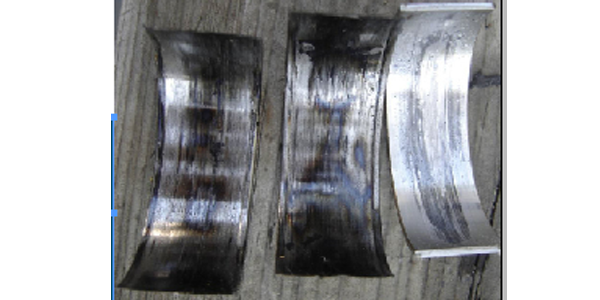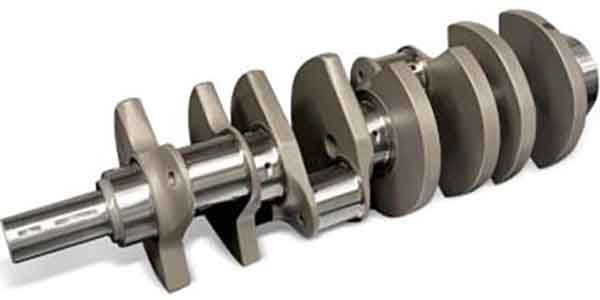One of the worst failures that can occur inside an engine is a spun bearing. It can happen in a stock engine, race engine, gasoline engine or diesel engine. A spun bearing is bad news because it usually seizes itself around the crankshaft journal. What happens next depends on the bearing’s location. Spun rod bearings are the most common failure. A spun rod bearing will tear up the big end bore in the rod, ruin the rod journal on the crankshaft, and sometimes break the connecting rod. That’s really bad news because a broken rod flailing around inside an engine can obviously do a lot of damage! A spun main bearing will tear up the main bore in the block but rarely will it cause the crank to fail. The damage is usually limited to the main journal surface on the crank and the main bore housing. A spun cam bearing will tear up the bearing bore in the block (or head in the case of an OHC cam), and possibly snap a timing belt or chain – which may result in one or more bent valves if it’s an interference engine. In some cases, the cam bearing seizure may even snap the cam.
Various Causes
A spun bearing is usually the end result of a chain of unfortunate events. These include high operating loads, excessive heat and a loss of lubrication.
Spun bearings are often blamed on a loss of oil pressure, but there can be numerous contributing factors that eventually cause the bearing to seize and spin. Normally, bearings allow the crank glide on a hydrodynamic film of oil between the bearing surface and journal. As long as there is a steady supply of clean, fresh oil flowing into the gap between the bearing and journal, everything is fine. The film only has to be a few microns thick to maintain protection. But if there is a sudden loss of oil pressure and flow, especially at high RPM, the protective film can disappear in an instant. Once that happens, you get metal-to-metal contact between the bearing and journal surfaces, which causes scuffing, increased friction and heat.
It doesn’t matter what type of bearing is involved, be it aluminum or a babbitt-faced tri-metal, because all types melt start to melt around 450 degrees F or so. A babbitt overlay on a tri-metal bearing offers good seizure resistance, but once it goes away the copper layer underneath lacks seizure resistance. Consequently, if there is enough scuffing, friction and heat due to a lack of lubrication, the bearing will melt, smear and stick to the crank journal. At that point you get a seized or spun bearing with whatever additional damage it causes.
Although this may happen suddenly, often there has been an ongoing lubrication problem that has caused a bearing to scuff, run hot and overheat. This can discolor the crank journal and/or blacken the big end of the rod. So if you tear down an engine and see such signs of overheating, it’s a solid clue that the engine has an oiling issue that needs to be identified and corrected before it’s put back together.
Contributing factors that can cause oil pressure and lubrication problems in an engine include:
- Low oil level in the oil pan due to leaks, maintenance neglect or improper filling.
2. Oil pump cavitation and aeration at high RPM due to pump design, restrictions in the pump inlet tube or pickup, or oil sloshing away from the pickup in the bottom of the pan due to extreme cornering, acceleration or braking forces.
3. Blocked or partially blocked oil gallery or oil filter.
4. Bearings installed incorrectly (oil holes do not line up with the gallery holes). This is especially important with cam bearings that can be easily misaligned.
5. Bearing clearances too tight for the oil viscosity being used. Late model engines such as a Chevy LS or Ford modular V8 with tighter main and rod bearing clearances of .0015˝ to .002˝ usually require a thin multi-viscosity motor oil such as 5W-20. Fill the crankcase with a relatively thick racing oil and you’ll have problems right from the start. Tighter bearing clearances require thinner oils while looser bearing clearances of .003˝ to .004˝ in “old school” motors and race motors require thicker oils (20W-50 or 50W) to maintain the protective oil film between the bearings and their journals.
6. Misalignment of the bearing shell and crank journal.
7. Mistakes made when machining housing bores or crank journals (wrong diameters).
8. Cold starts, especially in close tolerance racing engines running thicker oils.
9. Extremely high bearing-to-crank loads due to lugging, detonation or high boost or nitrous applications.
CRUSH FIT
One of the things that helps hold bearings securely in position so they don’t spin in their bores is crush fit (or press fit in the case of cam bearings). Crush fit also promotes good heat transfer between the bearing and its housing so the bearings don’t overheat.
The amount of crush fit can vary somewhat depending on the application but is generally in the .002˝ to .004˝ total (.001˝ to .002˝ for each half of a rod or main bearing shell). According to one bearing supplier, .003˝ is about right for most applications.
The actual amount of crush fit that is built into a bearing by a bearing manufacturer is based on their engineering analysis of the application and the OEM main bore, connecting rod and cam bearing specifications. The bearing shells are then made so they protrude slightly above the parting line. When the main cap, rod cap or cam bearing cap is tightened down, the bearing crushes slightly to hold it securely in place. The little locating tangs or lugs on the bearing shell are there for alignment purposes only and do not play a role in holding the bearing in its housing.
Checking crush fit is tricky, and according to most bearing manufacturers cannot be measured accurately enough on a workbench or in the field. When you place the half shell of a bearing in a main bore, main cap, connecting rod or rod cap, the ends of the bearing will be slightly higher than the parting line of the housing or cap in which it is sitting. Using a feeler gauge to measure how far the ends of the bearing are above the surface won’t necessarily give you an accurate indication of crush fit because the bearing has a certain amount of built-in spread that will deform as the bearing is tightened in its housing.
To accurately determine crush fit, bearing manufacturers use a special block gauge to measure the bearing after it has been installed in a bore with a known size the cap has been torqued down to specifications. If crush fit is correct, the bearing will be held snugly in place without too much deformation that could cause clearance problems.
Crush fit has to be more or less exact because too much crush fit may deform the bearing to such an extent that it rubs against its journal. Insufficient crush fit means the bearing will not be held firmly in place and may move back and forth within its housing, increasing the risk of it spinning or seizing. Insufficient crush can also cause a bearing to run hot because of poor heat transfer between the back of the bearing and its housing. Over time, this can cause the bearing to degrade and fail.
Thermal expansion is another factor to consider when it comes to crush fit. Aluminum blocks and rods expand more than their cast iron counterparts. An aluminum housing bore with a diameter of 2.25˝ will expand by .003˝ over a 200 degree F temperature change, whereas steel will only increase by .0015˝. Consequently, if a bearing lacks sufficient crush fit (or interference fit in the case of a cam bearing in a pushrod block), the bearing may loosen up when the engine gets hot, increasing the risk of it spinning.
Possible causes of insufficient crush include:
• Using incorrectly sized or smaller OD bearings than the housing.
• Insufficient or incorrect tightening of the main bearing cap bolts or rod bolts during installation.
• Rod bolt stretch – especially at higher RPM in a race engine.
• Burred, dirty or damaged rod or main caps that preventing correct assembly and loading of the bearing.
• Housing bore not within specifications (too large to hold the bearing shells securely).
Reduce the Risk
If an engine has suffered a spun rod or main bearing, and the engine is rebuildable, it will require resurfacing the crank journal, possibly re-machining the main bore or big end rod bore (or replacing the rod) depending on the damage that has occurred. The replacement bearings will also have to be correctly sized to compensate for any changes in bore diameter so they fill fit properly when installed. New main and/or rod bolts are also recommended. Don’t reuse torque-to-yield (TTY) bolts because they stretch when tightened and may break if reused.
Follow basic assembly rules such as prelubing the front of the bearings with assembly lube or oil, and making sure the backs of the bearing shells are clean and dry.
If you are building a race motor, use performance bearings rather than stock bearings. Race bearings have stronger materials that can handle higher loads, and they have more eccentricity to help form the oil wedge that provides hydrodynamic lubrication, especially at higher engine speeds.
Make sure engine has no oiling issues and is capable of achieving and maintaining good oil pressure. Check the oil pump for wear, damage or excessive clearances and replace as needed. Make sure the oil pump pickup tube is secure and the pickup screen is unobstructed and located at the proper height above the bottom of the oil pan. If you’re building a race motor, make sure the oil pump can deliver the oil flow the engine will need at high RPM.
Make sure the oil pan is filled with the correct amount and viscosity of oil before the engine is fired up. Also, prime the oil system to prevent a dry start. And make sure the engine is getting good oil pressure once it is running.
Coated Bearings
Opinions differ as to whether or not coated engine bearings can prevent or reduce the risk of spun bearings. Anti-friction coatings can help prevent metal-to-metal contact in engines that undergo frequent start-stop cycles, such as many late model engines with fuel saving idle stop/start systems. Small displacement diesel engines can also be hard on bearings. That’s why coated bearings may be used in these applications. According to some suppliers who offer special anti-friction and anti-wear coatings, bearing life can be extended significantly with these coatings.
In a performance application, a coated bearing is not required but may provide some extra protection against dry starts as well as metal-to-metal contact should oil pressure drop momentarily during a race. At that point, the coating becomes a temporarily replacement for the oil film that has gone away. By sacrificing itself, it may prevent the bearing from scuffing, seizing and spinning – but for how long is anyone’s guess.
Under racing conditions, a coating by itself is no substitute for oil and will eventually wear away. It may happen in a matter of seconds or it may take a couple of laps. Either way, it’s going away. However, if the driver is aware of the problem (like a blown oil line spraying oil and zero oil pressure showing on the gauge), he may react quickly enough and shut down the engine before it’s too late and the engine blows. In such an instance, the extra money spent on a set of coated bearings would more than pay for itself by saving the engine.












